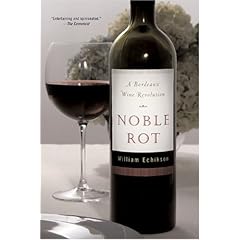 A stench wafts among the pricey vineyards of Bordeaux. According to Noble Rot by William Echikson, the stink comes from a cultural gangrene eating away at an arrogant and outmoded aristocracy so far into denial that it can’t see the mortal danger that corrodes it from within.
A stench wafts among the pricey vineyards of Bordeaux. According to Noble Rot by William Echikson, the stink comes from a cultural gangrene eating away at an arrogant and outmoded aristocracy so far into denial that it can’t see the mortal danger that corrodes it from within.In the wine world, the term "noble rot" refers to a specific type of desirable mold that allows grapes to produce some of the world's most desirable and expensive sweet wines with Bordeaux's Château d'Yquem at the pinnacle. But Echikson uses the term as a metaphor for a syndrome of cultural and enological afflictions that have turned this august wine region on its Gallic nose. The fact that Château d'Yquem plays a key role makes the metaphor doubly relevant.
The obscure and irrelevant Classification of 1855 stars as the lead pathogen in Noble Rot. As Echikson points out, the old guard in Bordeaux still clutch at the 1855 classification in a last-ditch effort to sell inferior wine at very high prices to gullible snobs who crave tony labels. Indeed, this 1855 list was never about quality from the beginning, but about price and prestige. Not coincidentally for this book, Château d'Yquem came out on the very top of that listing.
Leading the revolution against the established order are les garagistes, a feisty band of winemakers, mostly from St.-Emilion and environs who, zut alors!, think that Bordeaux's over-priced, thin, musty swill should give way to quality wine produced through proper vineyard management and winemaking techniques. While there are some larger, well-financed operations in this movement, most have been labeled garagistes after a number of prominent winemakers who literally began in their garages and produced wines that sell at hundreds of dollars a bottle at retail.
The fact that many unclassified garagiste wines are now selling at far greater prices than those with a noble, classified château on the label has outraged the establishment which, in Marie Antoinette fashion, scream, "Let them drink plonk!"
Echikson gives the reader a very readable, enjoyable sand factually grounded account of how the upstart garagistes first tried to change the ossified classifications which stood like the Maginot Line between them, formal recognition and the establishment's pricing and sales system. When that failed, they simply swept around the flanks, establishing alternate pricing, sales and distribution channels that cut the old guard off like la guillotine.
Noble Rot could easily have been like most wine books: morphine for the soul, filled with geek-speak, pedantically self-important and impenetrable prose suitable only for treating people with a sleep disorder. Yet Echikson avoids this and has produced an accessible, thoughtful book so filled with interesting material about the business, the winemaking and the culture that it begs to be sipped and contemplated rather than quaffed.
What makes the book so engaging is the way that Echikson spins his story by following some of the key people on both sides of the movement, leading us through the conflicts, offering context and illuminating quotes that promote understanding.
We have the challengers: true garagistes such as Michel Gracia and well-heeled newcomers like Florence Cathiard of Château Smith-Haut-Lafite who are bound by a passion for great wine regardless of classification. On their side are avant garde merchants like Jeffrey Davies, modern wine consultants like Michel Rolland and Denis Dubourdieu and well-known wine critic Robert Parker.
The old guard sees evil in the fact that Davies and Parker are American as are many of the new vineyard and winemaking practices is evidence, according to the old guard, that this was "part of a grand conspiracy to destroy France."
Echikson aptly shows that the French don't seem to need any outside help to destroy their country since government regulations, a refusal to modernize, a pervasive rear-view mirror on progress and a general xenophobia are doing a great job without American intervention.
Noble Rot uses this attitude as one of the major manifestations of denial that keeps the decadent aristocracy from addressing the real issues, which is why American wine regularly out-scores French wine in France and that top global honors for that icon of French culture, the baguette, has gone to one of my local Sonoma bakeries on more than one occasion.
Commanding the defense of the old order is Château d'Yquem's Alexandre Lur-Saluces. Noble Rot details his decades of subterfuge, double-dealing, and attempts to cheat family members out of their rightful ownership and control of Château d'Yquem all the while running the place into the ground. The tale, told through a combination of interviews and extracts from court cases paints a gothic image that would never have been believable even on Falconcrest.
The old guard cast would not be complete without the context that most of Bordeaux's old guard were Vichy supporters and Nazi collaborators who received many a fascist pat on the back for shipping Jews off to the gas chambers, something that grand cru lovers might want to keep in mind.
Noble Rot begins with many threads which Echikson skillfully weaves together in the last part of the book to form a unified, disturbing and yet optimistic tapestry. As the author of wine books, I have visited Bordeaux on a number of occasions and met many of the people Echikson writes about. I found that after reading Noble Rot, I had a far more coherent framework on which to hang my episodic visits and knowledge.
By Lewis Perdue




No comments:
Post a Comment